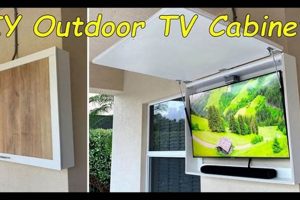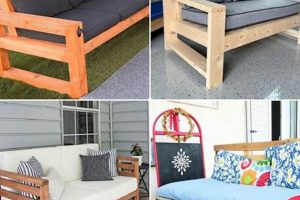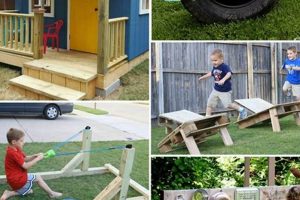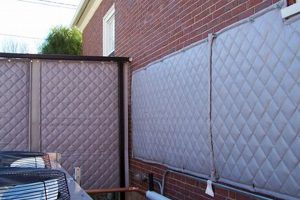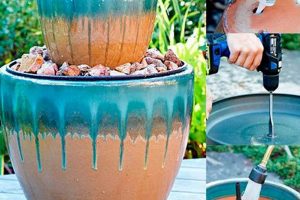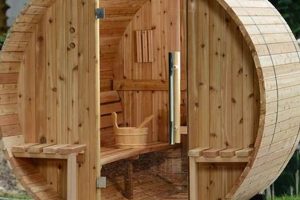The concept encompasses various strategies for constructing furnishings intended for outdoor spaces, specifically patios, through personal effort rather than commercial acquisition. This involves utilizing readily available materials, repurposed items, or standardized components to create seating, tables, and other functional elements suitable for al fresco living areas. For example, individuals might construct a coffee table from reclaimed wood pallets or build Adirondack chairs from dimensional lumber.
Engaging in this type of creation presents several advantages. It allows for customization to precisely fit spatial constraints and aesthetic preferences. Furthermore, it offers a cost-effective alternative to purchasing commercially manufactured pieces. Historically, self-sufficiency in crafting home goods, including outdoor furniture, has been a prevalent practice, particularly in periods of economic constraint or limited access to retail markets. The resurgence of this practice reflects a desire for personalized design and sustainable practices.
The subsequent sections will explore various project types, material considerations, design approaches, and relevant safety precautions related to this subject matter. Focus will be given to outlining practical methodologies and providing resources for successful execution.
Essential Considerations for Outdoor Furnishing Projects
The following outlines key factors for achieving durable and aesthetically pleasing results in outdoor furniture construction. Careful planning and execution are crucial for long-term satisfaction.
Tip 1: Material Selection: Choose materials resistant to weathering, insect infestation, and decay. Treated lumber, cedar, redwood, and certain types of durable plastics are suitable options. Consider the local climate and select accordingly.
Tip 2: Joint Construction: Employ robust joinery techniques, such as mortise and tenon, dovetails, or strong screw connections with exterior-grade adhesives. Weak joints are prone to failure under stress and environmental exposure.
Tip 3: Protective Finishes: Apply weather-resistant coatings, such as marine-grade varnish, exterior paint, or penetrating oil finishes, to protect the chosen materials from moisture and UV degradation. Regular maintenance of these finishes is necessary.
Tip 4: Ergonomic Design: Prioritize comfort by considering seat height, back support, and armrest placement. Measure existing furniture for comfortable dimensions or consult ergonomic guidelines to ensure proper posture and relaxation.
Tip 5: Drainage Considerations: Design furniture with adequate drainage to prevent water accumulation, which can lead to rot and material damage. Incorporate spacing between slats or angled surfaces to facilitate water runoff.
Tip 6: Hardware Selection: Utilize stainless steel or other corrosion-resistant hardware to prevent rust and staining. Pre-drill pilot holes to avoid splitting the wood when installing screws or bolts.
Tip 7: Weight Distribution: Ensure that the furniture is stable and can support the intended weight. Reinforce structural elements and consider the overall design to prevent tipping or collapse.
Tip 8: Safety Precautions: Wear appropriate safety gear, such as eye protection and gloves, when cutting, drilling, or applying finishes. Work in a well-ventilated area when using paints or adhesives.
Adherence to these guidelines will contribute significantly to the longevity, functionality, and aesthetic appeal of outdoor furnishings.
The concluding section will provide further resources and inspiration for pursuing this type of project.
1. Material Durability
Material durability constitutes a foundational element in the success and longevity of any do-it-yourself (DIY) outdoor patio furniture endeavor. The materials employed directly influence the furniture’s resistance to environmental factors, including moisture, ultraviolet (UV) radiation, temperature fluctuations, and potential pest infestations. Selection of inappropriate materials leads to premature degradation, resulting in structural failure and diminished aesthetic appeal. For instance, untreated softwood, when used in outdoor seating, will rapidly deteriorate due to moisture absorption, fostering rot and decay. Conversely, utilizing naturally decay-resistant hardwoods, such as teak or cedar, or employing pressure-treated lumber, significantly extends the lifespan of the constructed furniture, mitigating the negative effects of environmental exposure.
The implications of material durability extend beyond mere longevity. Durable materials reduce the frequency of repairs and replacements, translating to long-term cost savings. Furthermore, the selection of durable, sustainable materials aligns with environmentally conscious practices. For example, repurposing reclaimed lumber or utilizing recycled plastics not only provides cost-effective building materials but also reduces waste and minimizes the environmental impact associated with manufacturing new materials. Projects incorporating materials designed for outdoor use, such as marine-grade plywood or powder-coated metal, demonstrate an understanding of durability requirements and result in furniture better equipped to withstand the elements.
In summary, the intrinsic connection between material durability and DIY outdoor patio furniture cannot be overstated. It is a critical determinant of the furniture’s lifespan, aesthetic appeal, and overall value. Choosing appropriate materials, considering environmental factors, and prioritizing durability contribute to a successful project, yielding outdoor furnishings that withstand the test of time and provide sustained enjoyment. The initial investment in durable materials mitigates future costs and aligns with principles of sustainability.
2. Structural Integrity
Structural integrity represents a critical attribute in the realm of DIY outdoor patio furniture. Its presence dictates the furniture’s ability to withstand applied loads, environmental stresses, and general wear and tear over an extended period. Insufficient structural integrity results in furniture that is prone to failure, rendering it unsafe and unsuitable for its intended purpose. For example, a DIY patio chair constructed with poorly joined components may collapse under the weight of an individual, leading to potential injury. Conversely, well-designed and executed construction, incorporating robust joinery techniques and appropriate load-bearing materials, ensures stability and longevity.
The absence of adequate structural considerations can manifest in various ways. Warping, cracking, and joint separation are common consequences of improper design or construction. These issues not only compromise the furniture’s aesthetic appeal but also weaken its overall structure, accelerating its decline. A real-world example involves tables built with insufficient leg support; these structures are susceptible to tipping or collapsing when loaded unevenly. Prudent design incorporates factors such as weight distribution, load-bearing capacity of materials, and the appropriate use of reinforcement to mitigate these risks.
Achieving structural integrity in DIY outdoor patio furniture requires a comprehensive understanding of engineering principles, material properties, and construction techniques. Meticulous planning, precise execution, and careful material selection are essential. Ultimately, the structural soundness of the furniture directly correlates with its lifespan, safety, and overall value. Neglecting this fundamental aspect compromises the entire project, negating the benefits of cost savings and personalization that DIY endeavors aim to provide.
3. Weather Resistance
Weather resistance is paramount when considering do-it-yourself outdoor patio furniture. The degree to which a piece of furniture can withstand environmental elements directly impacts its longevity, appearance, and overall usability. Careful consideration of this aspect is thus essential for any successful outdoor furniture project.
- Material Selection and Climatic Conditions
The choice of materials must align with the prevailing climatic conditions. Humid climates necessitate materials resistant to rot and mildew, such as teak or treated lumber. Arid climates, conversely, may require materials that resist cracking and warping from extreme temperature fluctuations. The inappropriate selection compromises the structural integrity and aesthetic appeal of the furniture.
- Protective Coatings and Sealants
The application of protective coatings and sealants is critical in enhancing weather resistance. Marine-grade varnishes and exterior paints provide a barrier against moisture penetration and UV degradation. Regular maintenance, including reapplication of these coatings, is necessary to preserve the furniture’s integrity. The absence of such protection leaves the raw materials vulnerable to damage.
- Drainage and Ventilation Design
The design must incorporate adequate drainage and ventilation to prevent water accumulation and promote air circulation. This mitigates the risk of rot, mildew, and corrosion. Slatted designs, angled surfaces, and proper spacing between components facilitate water runoff and airflow, extending the lifespan of the furniture.
- Hardware Considerations
The selection of hardware, such as screws, bolts, and hinges, is a crucial aspect of weather resistance. Stainless steel or other corrosion-resistant materials are essential to prevent rust and staining. Substandard hardware will degrade over time, compromising the structural integrity of the furniture and potentially leading to failure.
The integration of these weather-resistant elements is fundamental for DIY outdoor patio furniture projects. Neglecting any of these facets will inevitably result in premature deterioration, increased maintenance costs, and a diminished aesthetic outcome. Prioritization of weather resistance ensures that the furniture withstands environmental challenges and provides lasting enjoyment.
4. Design Aesthetics
Design aesthetics, within the context of do-it-yourself outdoor patio furniture, function as a critical determinant of the final product’s perceived value and its integration with the surrounding environment. The aesthetic considerations extend beyond mere visual appeal; they encompass the furniture’s form, texture, color, and its relationship to the existing architectural and landscape elements. A successful DIY project considers these factors holistically to create a cohesive and visually pleasing outdoor space. For instance, crafting furniture with clean, minimalist lines may complement a modern patio design, while rustic, reclaimed wood pieces might better suit a garden setting. The deliberate selection of materials and design elements directly impacts the atmosphere and functionality of the outdoor area.
The absence of attention to design aesthetics can result in furniture that appears discordant or out of place, diminishing the overall enjoyment of the patio. Consider a situation where brightly colored plastic furniture is placed on a patio with a predominantly natural stone and wood aesthetic. The resulting contrast can be jarring, detracting from the intended ambiance. Conversely, thoughtful design choices can enhance the visual appeal of the space, creating a more inviting and relaxing environment. This might involve incorporating elements such as patterned cushions, strategically placed lighting, or the use of complementary color schemes. Furthermore, ergonomic design considerations also contribute to the overall aesthetic. Furniture that is both visually appealing and comfortable to use enhances the user experience.
In conclusion, the integration of design aesthetics is an indispensable component of effective DIY outdoor patio furniture projects. It affects not only the visual appeal of the furniture but also its integration with the environment and its overall usability. By considering these factors, individuals can create outdoor spaces that are both functional and aesthetically pleasing, enhancing their outdoor living experience. Recognizing this connection allows for informed decisions throughout the planning and construction phases, resulting in a final product that meets both practical and aesthetic requirements.
5. Ergonomic Comfort
Ergonomic comfort represents a significant, often underemphasized, component of successful do-it-yourself outdoor patio furniture endeavors. The physical well-being of users is directly affected by the design and construction choices made during the creation of seating, tables, and other patio furnishings. Ignoring ergonomic principles results in furniture that, while potentially aesthetically pleasing or cost-effective, causes discomfort, fatigue, or even physical strain during prolonged use. The inherent connection lies in the fact that the primary purpose of furniture is to provide support and facilitate relaxation; therefore, designs that fail to accommodate the natural contours and biomechanics of the human body are fundamentally flawed.
The practical application of ergonomic principles manifests in several key design elements. Seat height, seat depth, back support, and armrest placement all contribute to the overall comfort of a chair or bench. Tables should be designed at a height that allows for comfortable dining or working without straining the neck or shoulders. A real-world example is a patio chair constructed with a seat that is too low, forcing the user to sit in a squatted position, leading to back pain and discomfort. Conversely, a chair with adequate lumbar support and appropriately angled back promotes proper posture and reduces strain on the spine. These ergonomic considerations directly influence the usability and long-term enjoyment of the furniture. Failure to prioritize ergonomic comfort can negate any cost savings achieved through DIY construction, as the furniture becomes impractical for regular use. Furthermore, consideration of diverse body types and physical needs enhances inclusivity and expands the usability of the outdoor space.
In summary, ergonomic comfort is not merely an optional addendum but a fundamental design imperative for DIY outdoor patio furniture. It directly affects user well-being, usability, and long-term satisfaction. While aesthetic appeal and cost-effectiveness are relevant considerations, they should not supersede the importance of creating furniture that supports proper posture, reduces strain, and promotes relaxation. By integrating ergonomic principles into the design and construction process, individuals can create outdoor spaces that are both visually appealing and physically comfortable, enhancing their overall outdoor living experience.
6. Cost Efficiency
Cost efficiency represents a primary motivator for pursuing do-it-yourself outdoor patio furniture projects. The potential for significant cost reduction compared to purchasing commercially manufactured items renders this approach attractive to budget-conscious individuals. However, a comprehensive understanding of the factors influencing overall cost is crucial to realize genuine savings.
- Material Sourcing and Selection
The origin and type of materials directly influence project expenses. Utilizing reclaimed or repurposed materials, such as wood pallets or salvaged metal, minimizes material costs. Careful consideration of material properties is necessary; selecting less expensive, non-durable materials may lead to premature failure, resulting in replacement costs that negate initial savings. An example is choosing untreated pine over cedar for outdoor seating; the former’s lower initial cost is offset by its susceptibility to rot and subsequent need for replacement.
- Tool Acquisition and Utilization
The availability of necessary tools impacts overall project costs. Investing in specialized tools for a single project may undermine cost efficiency. Renting tools or borrowing from acquaintances can mitigate this expense. Furthermore, maximizing the utility of existing tools through careful planning and design reduces the need for additional purchases. In contrast, attempting to complete a project without the proper tools may result in damaged materials, rework, and increased overall costs.
- Design Complexity and Labor Investment
Intricate designs requiring specialized skills or extensive labor hours diminish cost efficiency. Simpler designs utilizing readily available materials and straightforward construction techniques minimize labor time and potential errors. For instance, building a basic Adirondack chair from pre-cut lumber is less labor-intensive and more cost-effective than constructing a complex, multi-component lounge chair. The value of personal labor must be factored into the overall cost assessment.
- Finishing and Protective Treatments
The application of protective finishes, such as paints, stains, or sealants, represents an additional cost factor. Selecting cost-effective, durable finishes that provide adequate protection against weather elements is crucial. Neglecting proper finishing, however, can lead to material degradation and increased maintenance expenses over time. An example includes opting for a less expensive, water-based sealant that requires frequent reapplication compared to a more durable, oil-based sealant.
Ultimately, achieving cost efficiency in do-it-yourself outdoor patio furniture projects requires a holistic approach. Consideration of material sourcing, tool utilization, design complexity, and finishing treatments is necessary to maximize savings and ensure long-term value. Prudent planning and execution are essential to transform the potential for cost reduction into tangible economic benefits.
7. Project Planning
Project planning serves as the foundational stage for any successful endeavor related to DIY outdoor patio furniture. It establishes a structured framework that directly influences the execution and ultimate outcome of the project. Without meticulous planning, the undertaking risks inefficiency, increased costs, and a final product that fails to meet expectations. This phase necessitates a clear definition of objectives, including the type of furniture to be constructed, desired aesthetic qualities, and functional requirements. A cause-and-effect relationship exists: deficient planning invariably leads to complications during construction, while thorough planning minimizes risks and optimizes resource allocation. Project planning inherently defines the parameters within which the creation occurs.
The importance of project planning manifests practically through various facets of the creation process. This includes accurate measurement of available space, which informs furniture dimensions and prevents the creation of pieces unsuitable for the intended location. Detailed material lists and cost estimations enable budget adherence, mitigating the risk of cost overruns. Furthermore, comprehensive plans encompass construction steps, joinery techniques, and finishing processes, reducing errors and enhancing the final product’s durability and aesthetic appeal. For instance, failing to account for material expansion and contraction due to weather fluctuations during the planning phase can result in structural damage over time. Conversely, proper planning anticipates these effects, leading to a more resilient and enduring piece of furniture. Consider the example of crafting a patio table; lacking a well-defined plan, the builder might underestimate the material quantities, employ inadequate joinery, or neglect weatherproofing, thereby compromising the table’s structural integrity and longevity.
In conclusion, project planning is not merely a preliminary step but an integral component of DIY outdoor patio furniture projects. Its practical significance lies in its ability to mitigate risks, optimize resource allocation, and enhance the final product’s quality. Comprehensive planning leads to a more efficient, cost-effective, and satisfying creative process. Recognizing this critical connection is essential for anyone embarking on such a project, as it transforms a potentially chaotic undertaking into a structured, achievable goal. Despite the allure of spontaneous creation, the absence of methodical planning frequently leads to suboptimal outcomes and wasted resources. Embracing meticulous project planning, therefore, is paramount to realizing the full potential of DIY patio furniture construction.
Frequently Asked Questions
The following addresses common inquiries regarding the design, construction, and maintenance of do-it-yourself outdoor patio furniture. Accurate information facilitates successful project completion and ensures long-term satisfaction.
Question 1: What are the most suitable materials for constructing weather-resistant outdoor furniture?
Durable hardwoods like teak, cedar, and redwood exhibit natural resistance to decay and insect infestation. Pressure-treated lumber offers a cost-effective alternative, requiring proper sealing and finishing. Recycled plastics and metal are viable options, provided they are designed for outdoor use.
Question 2: What joinery techniques provide the strongest and most durable connections for outdoor furniture?
Mortise and tenon joints, dovetail joints, and robust screw connections with exterior-grade adhesives are recommended. Weak joints compromise structural integrity, leading to premature failure under stress and environmental exposure.
Question 3: How can one ensure that DIY outdoor furniture is ergonomically comfortable for prolonged use?
Consider seat height, seat depth, back support, and armrest placement. Adherence to ergonomic guidelines or replicating dimensions from comfortable existing furniture is advisable. Prioritizing user comfort enhances the usability of the outdoor space.
Question 4: What protective finishes are essential for safeguarding outdoor furniture from moisture and UV degradation?
Marine-grade varnishes, exterior paints, and penetrating oil finishes provide a protective barrier. Regular maintenance, including reapplication of these coatings, is necessary. Neglecting this aspect accelerates material deterioration.
Question 5: What are the primary safety precautions to observe when constructing DIY outdoor furniture?
Eye protection, gloves, and appropriate respiratory protection are essential when cutting, drilling, or applying finishes. Work in a well-ventilated area. Securely clamp workpieces to prevent movement during machining operations.
Question 6: How can one minimize the cost of DIY outdoor furniture projects without compromising quality?
Utilize reclaimed or repurposed materials, rent specialized tools, and choose simpler designs. Carefully plan material purchases to minimize waste. Compare prices from different suppliers. Prioritize durability to avoid future replacement costs.
Adherence to these recommendations enhances the likelihood of successful DIY outdoor furniture projects, resulting in aesthetically pleasing and functional outdoor spaces.
The subsequent section will explore design inspirations and practical examples of DIY outdoor furniture creations.
Conclusion
This exposition has presented a comprehensive analysis of do-it-yourself outdoor patio furniture ideas. Key points addressed encompass material selection, structural integrity, weather resistance, design aesthetics, ergonomic comfort, cost efficiency, and project planning. A thorough understanding of these elements is paramount for the successful construction of durable, aesthetically pleasing, and functional outdoor furnishings.
Effective implementation of these principles fosters self-sufficiency and resourcefulness in enhancing outdoor living spaces. While this analysis provides a foundational understanding, continuous learning and adaptation remain essential for optimal results. The significance of prioritizing informed decision-making throughout the project lifecycle cannot be overstated.


